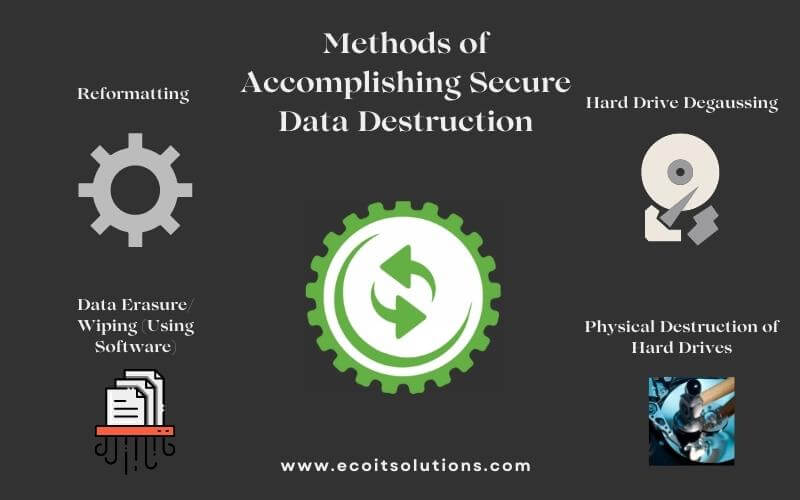The Impact of Effective Data Destruction on Cyber Security Risk Monitoring
The Impact of Effective Data Destruction on Cyber Security Risk Monitoring
Blog Article
The Value of Effective Information Destruction Practices in Shielding Sensitive Information and Ensuring Computer System Safety
In an era where information breaches are increasingly typical, the value of effective information damage practices can not be overstated. Applying durable data devastation approaches not just reduces these risks yet also aligns with lawful compliance needs, ensuring that companies maintain their track record and foster client trust fund.
Comprehending Information Damage
Comprehending information destruction is essential in today's digital landscape, where delicate info can easily be compromised. Reliable data damage entails not merely guaranteeing but deleting documents that data is irretrievable through comprehensive approaches. This process is vital for companies that take care of personal customer details, copyright, or inner records, as any type of breach can bring about serious monetary and reputational effects.
Data destruction encompasses numerous techniques, including shredding physical media, degaussing magnetic storage space tools, and using software-based services that overwrite information several times. Each technique serves a particular purpose and should align with the level of sensitivity of the information being taken care of. Physical devastation is often chosen for difficult drives containing very private information, while software application techniques may be adequate for much less sensitive information.
Furthermore, sticking to industry criteria and regulations, such as the General Data Defense Policy (GDPR) or the Wellness Insurance Transportability and Liability Act (HIPAA), is crucial for conformity and to minimize lawful risks. Organizations needs to establish a robust data destruction policy, train staff members on best practices, and frequently examine their treatments to make certain that all sensitive info is dealt with securely and properly.
Dangers of Inadequate Practices
Insufficient information destruction methods subject companies to significant risks that can have significant consequences. When delicate information is not effectively thrown away, it continues to be at risk to unauthorized access, which can result in information violations and identification burglary. Such occurrences not only jeopardize the safety and security of people yet additionally taint the organization's reputation, leading to a loss of customer trust and prospective financial effects.
In addition, regulatory conformity is increasingly stringent in lots of sectors. Failing to follow information devastation guidelines can lead to substantial penalties and legal actions versus companies. These penalties can draw away and strain monetary resources focus from core organization procedures.
On top of that, the abuse of recurring information can bring about copyright theft or corporate espionage, threatening affordable advantages (data destruction). The impact of insufficient data destruction extends beyond instant monetary losses; it can additionally result in long-lasting damages to brand integrity and market position

Organizations should recognize that data protection is not solely about stopping violations; it additionally includes the responsible management of information throughout its lifecycle. Disregarding efficient data damage procedures can have disastrous implications, emphasizing the need for robust procedures to mitigate these dangers.
Finest Practices for Information Damage
Executing reliable data damage techniques is necessary for protecting sensitive details and maintaining compliance with regulative standards. Organizations needs to take on a multi-faceted approach to guarantee that data is irretrievable, consequently avoiding unauthorized accessibility and possible breaches.
First, information should be categorized based upon level of sensitivity, allowing organizations to apply proper devastation methods tailored to the degree of risk. For electronic data, making use of software-based data-wiping tools that follow sector requirements can properly overwrite existing information. Physical destruction techniques, such as shredding or degaussing, are essential for sites devices that store sensitive info, ensuring full obliteration.
Developing a clear data retention policy is crucial, outlining how much time various sorts of information must be maintained prior to devastation. Routine audits of information storage systems are also necessary to recognize unneeded or out-of-date information needing elimination.
Furthermore, training staff members on the relevance of data damage and the details methods to follow fosters a culture of safety within the company. Preserving paperwork of data destruction processes supplies liability and supports compliance with internal plans and exterior regulations. By sticking to these finest practices, organizations can dramatically reduce the threats related to information exposure.
Legal and Compliance Considerations

Failing to follow these laws can result in serious charges, consisting of substantial penalties and reputational damages. Organizations should carry out a durable information destruction policy that aligns with these lawful frameworks and gives clear guidelines on the appropriate approaches of data disposal, whether physical shredding or digital cleaning.
Additionally, keeping paperwork of information damage tasks is necessary for demonstrating conformity throughout audits or assessments. By focusing on lawful and compliance factors to consider, organizations can enhance their information security pose and foster trust with customers and stakeholders, ultimately adding to an extra safe and secure data administration atmosphere.
Benefits of Effective Information Destruction
Efficient data devastation methods extend beyond plain compliance; they provide considerable advantages to companies that prioritize them. By making certain that sensitive details is irretrievably destroyed, organizations reduce the threat of information breaches and the potential financial repercussions linked with them. This aggressive method not just safeguards versus unauthorized gain access to but likewise improves the general dependability of the organization in the eyes of stakeholders and customers.
Executing durable information devastation approaches, such as physical devastation of storage space tools or innovative information wiping techniques, adds to the fortifying of a company's cybersecurity stance. data destruction. It minimizes the likelihood of additional hints copyright burglary and shields exclusive info, therefore keeping an one-upmanship out there

Conclusion
In conclusion, effective data destruction methods are crucial for protecting sensitive details and enhancing overall computer system security. Ultimately, a dedication to robust information devastation approaches cultivates a culture of duty, thereby enhancing an organization's cybersecurity position and preserving client count on.

Report this page